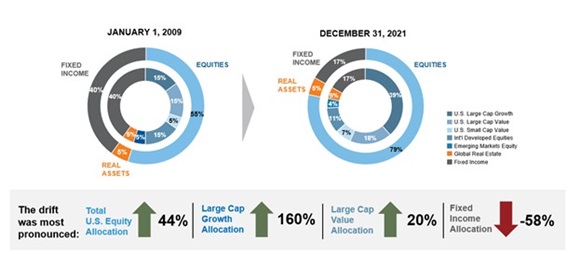Value of an advisor: A is for the active rebalancing of investment portfolios
Rebalancing an investment portfolio may not seem as crucial when financial markets rise as relatively steadily as they did in 2021. But we believe rebalancing remains as important as ever, and a vital component of the value that advisors provide.
At Russell Investments, we champion the value of an advisor. We believe there are myriad ways that advisors provide value to their clients—value that is above and beyond the fees they charge. But we also believe that many advisors struggle to quantify that value. More importantly, they often struggle to communicate that value.
This is the ninth year that we have produced our Value of Advisor study demonstrating the value that advisors can add through the holistic wealth management services they provide. As investor demands and needs increase, we have found that many advisors have broadened and deepened the services they offer, and by extension, their value.
This is the first of a series of blogs that will do a deeper dive into each of the components of our Value of Advisor study. In this blog, we will look at the importance of active rebalancing.
You can also watch our short video on the importance of active rebalancing on YouTube.
A—for active rebalancing of investment portfolios—remains the first letter in our revamped Value of Advisor formula, reflecting its importance no matter the market environment.
We believe that advisors who actively rebalance their investors’ portfolios to maintain the original asset allocation are providing value that may not be recognized—not even by the advisors themselves.
The value of rebalancing is often downplayed. Since it’s a routine part of the traditional management of investor portfolios, many advisors may not realize the true value it can bring. But as we can demonstrate, rebalancing (or not) can have a substantive impact on a portfolio.
Rebalancing can add value in three ways—in maintaining an investor’s mix of assets to the original allocation, in potential return and in reducing volatility. In this year’s study, the value of rebalancing was weighted toward the role it plays in keeping the strategic asset allocation on track—and therefore remaining appropriate for the investor’s stated goals. It also provided slightly higher risk-adjusted return and reduced volatility.
First, let’s consider the impact on the investor’s asset allocation. For example, if an investor had purchased a hypothetical balanced portfolio of 60% equities and 40% fixed income in January 2009 and not had it rebalanced since then, by the end of 2021 the portfolio would look quite different.
The investor would be heavily invested in equities—84% of the portfolio—and not enough in fixed income—17% of the portfolio. Remember, fixed income is generally considered the stabilizing element in a portfolio to offset the volatility of equities. Such a huge imbalance could expose the investor to the risk of a significant drawdown if equity markets fell sharply. That could make for a difficult conversation with a client.
When balanced becomes the new growth: The potential result of an un-balanced portfolio
Click image to enlarge
For illustrative purposes only. Not intended to represent any actual investment. Diversified portfolio consists of 30% U.S. large cap, 5% U.S. small cap, 15% non-U.S. developed, 5% emerging markets, 5% REITs, and 40% fixed income. Returns are based on the following indices: U.S. large cap = Russell 1000® Index; U.S. small cap = Russell 2000 Index; non-U.S. developed = MSCI EAFE Index; emerging markets = MSCI Emerging Markets Index; REITs = FTSE EPRA All Equity REITs Index (1/1/2002-2/28/2005) and FTSE EPRA Nareit Developed Index (2/28/2005-Present); and fixed income = Bloomberg U.S. Aggregate Bond Index.
Do you think most investors even realize that this can happen? Do they recognize the value of active rebalancing and how it’s a vital part of wealth management? If advisors don’t talk about rebalancing, then we can’t expect investors to understand its importance.
Actively responding to changes in the markets may also help boost returns and has the potential to reduce risk. By risk, we mean volatility, which is often what causes investors to doubt their investment plan and pull money out of the market.
We consistently find there’s a big gap between what investors believe advisors do and what advisors actually do. In other words, there’s a value communication gap between advisors and their clients. But what if you could tell your clients that by regularly rebalancing their portfolio, you have maintained their asset allocation in line with their goals, helped smooth out returns and maintained their desired risk profile?
We recommend four simple touchpoints to make the communication both easy for you and meaningful for your investor clients.
- The potential benefits of an active rebalancing policy—Explain what can happen if rebalancing doesn’t happen and how rebalancing regularly helps keep their portfolios on track with their goals and their risk profiles.
- What the rebalancing policy is—Let your clients know the basics of the policy, how it works to be both efficient and oriented toward their desired outcomes.
- How frequently the portfolios are rebalanced—Explain how often you will rebalance their portfolio and why you believe that frequency makes sense for them.
- The importance of actively rebalancing during periods of market volatility—Let your clients know how taking actions that may seem counterintuitive—such as reducing their exposure to the fastest-growing segments of the market—can help them avoid costly mistakes, such as following the herd, buying high and selling low, and leaving the market at the worst times.
The bottom line
In the formula of advisor value, A is for actively rebalancing investor portfolios. As we have shown, rebalancing can help maintain an investor’s established asset allocation, it has the potential to boost returns and it can help smooth out volatility. And that in turn can help investors meet their desired financial goals. That is valuable and is something investors should understand. We think you should let them know.
To learn more about the Value of Advisor study, click here.
